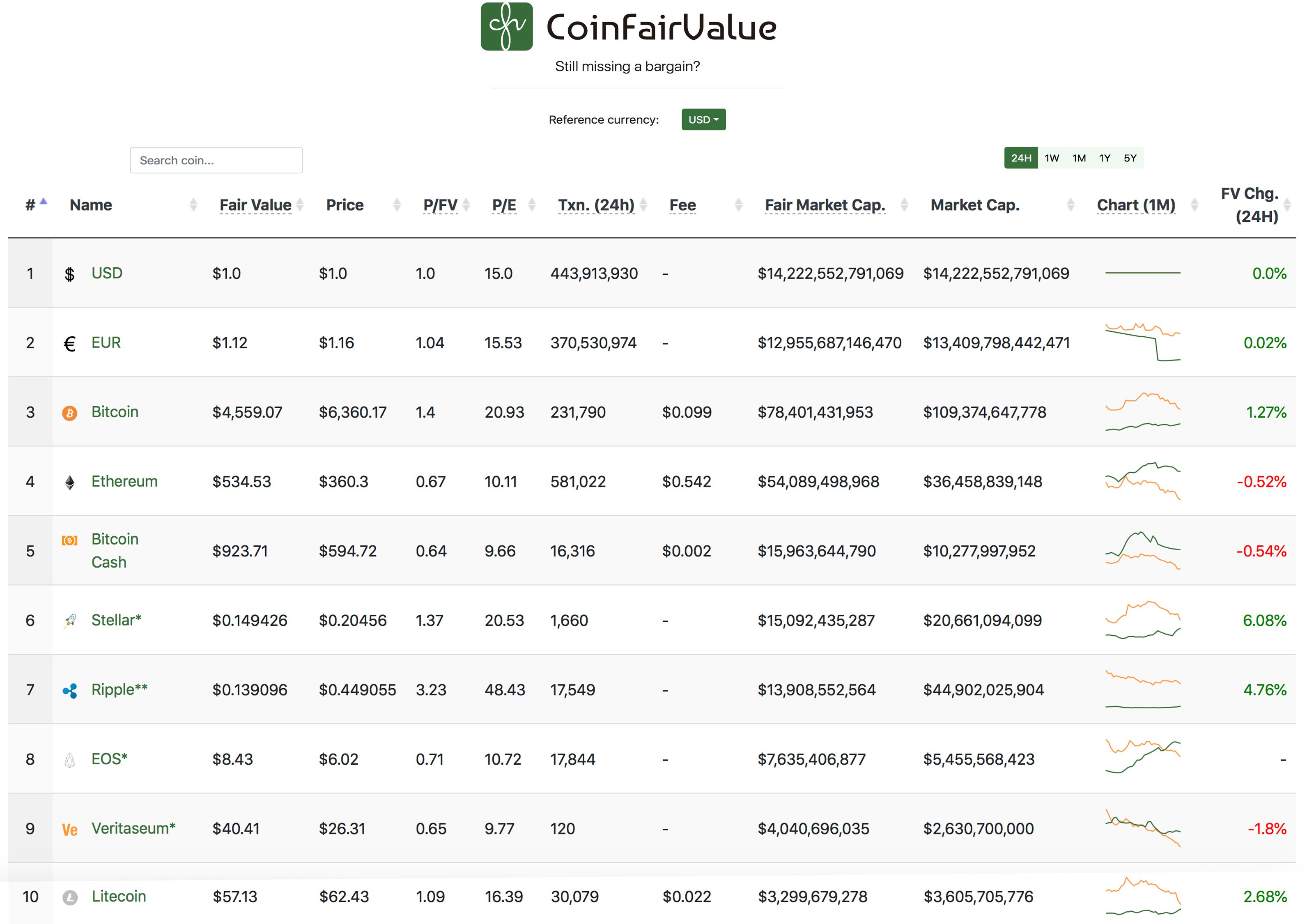Latest news about Bitcoin and all cryptocurrencies. Your daily crypto news habit.

When people look at the fiat value of cryptocurrencies they usually observe prices from data sites like Coinmarketcap.com that pull aggregated digital asset spot prices from exchanges all across the world. Now there’s another market capitalization website that people may be interested in, called Coinfairvalue.com, a platform that’s a touch different than the normal data sites because it measures fair values without any implied speculation.
Also read: Electron Cash Wallet Now Available for Basic Feature Phones
This Website Highlights Cryptocurrencies and Fair Value
 Coinmarketcap.com (CMC) and the variety of other price data websites are common places people like to visit to find out the value of their favorite cryptocurrencies. Most websites like this aggregate all the spot prices from exchanges across the world and find the median average. This is why sites like CMC’s prices are different than when an individual observes the feed from a single exchange. Now there’s another site called Coinfairvalue.com (CFV) that lists the top cryptocurrency valuations but instead of using aggregated spot prices it measures fair values based on the current usage of each coin. Basically, the website is based upon the ‘Currencies Fair Value’ model published by Pablompa in 2017, explain the creators of CFV. The Pablompa model assesses compounded fair value by measuring actual real-world use by utilizing publicly available blockchain data.
Coinmarketcap.com (CMC) and the variety of other price data websites are common places people like to visit to find out the value of their favorite cryptocurrencies. Most websites like this aggregate all the spot prices from exchanges across the world and find the median average. This is why sites like CMC’s prices are different than when an individual observes the feed from a single exchange. Now there’s another site called Coinfairvalue.com (CFV) that lists the top cryptocurrency valuations but instead of using aggregated spot prices it measures fair values based on the current usage of each coin. Basically, the website is based upon the ‘Currencies Fair Value’ model published by Pablompa in 2017, explain the creators of CFV. The Pablompa model assesses compounded fair value by measuring actual real-world use by utilizing publicly available blockchain data.
“Our Market Cap differs from Market Caps in other sites because we do not make the artificial distinction between Circulating Supply and Supply,” explains the CFV website.
Let’s put it simply: the fact that the founders hold a part of the supply does not make their part of the supply less circulating than a part of the supply held for years by an investor. “Static” supply is reflected in the Velocity of Money. The more “static” supply within the total supply, the smaller the velocity – hence, the higher the tendency to hold savings.
 The dollar and the euro are included in Coinfairvalue.com’s list.
The dollar and the euro are included in Coinfairvalue.com’s list.
An Entirely Different Look at the Top Cryptocurrencies
The CFV data is interesting for many reasons and one of them is because the top two currencies are USD and EUR which is not usually included in other market cap websites. USD has the fair market value (FMV) of $1 per unit while the EUR has an FMV of around $1.12 per unit at the time of writing. Both currencies have market caps that exceed $12-14 trillion dollars and the USD market capitalization is 12,903 percent larger than BTC’s $109B, according to CFV. The website’s creators believe USD and EUR should be included because fiat currencies have an uncertain future supply function. But CFV notes that data is sparse when it comes to the number of trades in a given period with fiat, and “the consequence is that there is poor clarity on their fair value.”
 The top ten currencies according to the website’s data.
The top ten currencies according to the website’s data.
The top five cryptocurrencies are very different than the values recorded on websites like CMC. Bitcoin core (BTC) prices, for instance, are around $6,360 per coin at press time, but the currency’s FMV on Coinfairvalue.com is $4,559. The second highest market capitalization held by ethereum (ETH) today is $360 per ETH, but CFV’s data suggests it should be worth more at $534 a coin. Usually, ripple (XRP) takes the third position on most sites but on CFV’s site, bitcoin cash is the third highest valued coin. BCH spot prices today are around $594 but CFV has the fair value priced at $923 per BCH. Ripple (XRP) should be only $0.13 per coin rather than today’s overvalued spot price of around $0.44 according to the website. EOS prices on CFV say that EOS is undervalued and should be worth $2.40 per coin more than its current market price of $6.
Another List Called “Honest Coinmarketcap” and the Rational Behind the Currencies Fair Value Model
CFV’s website is sure to be controversial to some cryptocurrency proponents, but there have been many attempts to create more realistic coin market cap data. Just recently, news.Bitcoin.com reported on a spreadsheet created by Andrew Rennhack that he calls “Honest Coinmarketcap.” Rennhack’s aggregated data is based on global cryptocurrency volumes because the researcher claims a great majority of BTC and ETH volumes are phony. Using parts of the Currencies Fair Value model, the CFV website creators believe their data is rational.
“It arrives at the rational conclusion that currencies must be trading at their fair value when the number of speculative trades in the particular currency itself is negligible with respect the total number of overall trades conducted using the same currency as a tool, such as in the case of when someone trades BTC for BCH because he thinks BCH will perform better,” Coinfairvalue.com details.
It also arrives at the conclusion that even when the number of speculative trades is not negligible, and the aggregated number of speculative trades is also unbiased and cancels out, then this indicates that the currency must be trading at its Fair Value — With that in mind, while analyzing the charts, it is in fact possible to determine how much speculation occurred.
What do you think about Coinfairvalue.com’s price assessments? Let us know your thoughts in the comment section below.
Images via Shutterstock, and Coinfairvalue.com.
At news.Bitcoin.com all comments containing links are automatically held up for moderation in the Disqus system. That means an editor has to take a look at the comment to approve it. This is due to the many, repetitive, spam and scam links people post under our articles. We do not censor any comment content based on politics or personal opinions. So, please be patient. Your comment will be published.
Disclaimer
The views and opinions expressed in this article are solely those of the authors and do not reflect the views of Bitcoin Insider. Every investment and trading move involves risk - this is especially true for cryptocurrencies given their volatility. We strongly advise our readers to conduct their own research when making a decision.